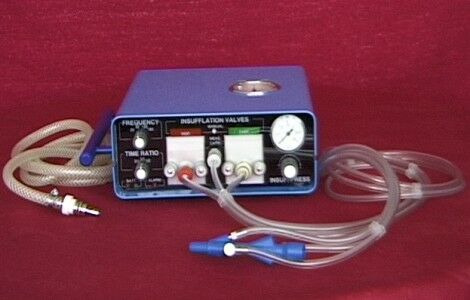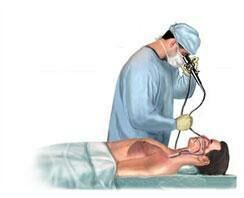High frequency ventilation PARAVENT PATe


- A specialty respiratory care device, designed for short term clinical use
- Supports a range of clinical situations with its unique features and properties
- Based on the scientific principles and physical properties of the patented Multi-Nozzle Jet Injector (MNJI) which generates the constant pressure and creates the jet stream
The Patented Multi-Nozzle Jet Injector

Patient Care and Safety
The OB1 ParaVent’s MNJI has a central Open channel, eliminating the risk of hyperinflation or barotrauma. Flow through the MNJI is actively Bi-directional.
The active expiratory support enables the unique Expulsion effects of the OB1, allowing for the removal of foreign matter (solids or liquids, such as meconium, secretions, aspirate, blood particles, contrast media) and because of the Open central channel, there is no risk of lung collapse.
Simplicity Defined – Automatically
Setting up the OB1 ParaVent couldn’t be easier. There are 8 different sizes of MNJI’s, corresponding to ET tube sizes 3 through 10.
Simply choose the same size MNJI as the patient’s ET tube, and that’s it – all ventilator parameters are now predefined and calibrated by the selection of the right MNJI with its unique physical shape and properties.
Each MNJI is equipped with three inspiration nozzles and one expiration nozzle as well as an Paw connector. Ventilator performance can be adjusted in the range of ±50% simply by changing the inspiration nozzle (I, II, III).
For intubated and non-intubated patients, from 600g to 140kg, there is only ever 1 ventilator you need.
Programmable Impulsion and Expulsion Effects
The Impulsion (1:2) and Expulsion (2:1) modes create active impulsion and expulsion effects.
Whilst continuing to ventilate your patient, you can now use the OB1 ParaVent for Lung cleaning, more effective application of pharmaceutical solutions (e.g. surfactant, mukolytics, therapeutic Aerosols, local anaesthetics, catecholamines, etc…) and programmable movement/extraction of foreign objects or obstructions in the airways (solid, semi-solid, liquid) such as including meconium, aspirate, excessive secretions, blood, particles, and contrast media.
NIMV with Acute Respiratory Failure & COPD patients
NIMV is an increasingly popular choice of therapy in acute respiratory failure and exacerbation of COPD patients. It is generally accepted that for positive outcomes the following prerequisites are required:
- Patient is able to cooperate
- Patient can control airway and secretions
- Adequate cough reflex
- Patient is able to co-ordinate breathing with ventilator
- ref: Sharma, www.theiaforum.org, January 2004 (1)

The OB1 ParaVent overcomes ALL of these limitations – it can produce artificial coughs, even in non-cooperative patients.
The open circuit design allows spontaneous breathing, so patients do not have to co-ordinate with the ventilator.
The unique Expulsion effect of the OB1 ParaVent can deal with excessive secretions whilst continuing to ventilate the patient.
And best of all, improved pulmonary mechanics and oxygenation occurs in a fraction of the time it takes with conventional NIMV devices.
Transport of Neo-Natal and Paediatric Patients on HFOV
Critically ill patients on HFOV often react poorly to transport situations, due to the fact that transport ventilators only offer conventional modes of ventilator support – until now.
The OB1 ParaVent offers high-frequency ventilation, up to 180 bpm, and its small size and weight (4.5 kg) and battery life (up to 8 hours on 4 AA batteries) make it an ideal choice for transport of patients on HFOV.
Transport of Neo-Natal and Paediatric Patients on HFOV

The OB1 ParaVent is powerful enough to ventilate through 10m long non-metallic catheters, and due to the open channel it is also safe for your patients, making it an elegant solution for use in the MRI.
When used with high frequency ventilation mode, it also minimises chest wall movement, another advantage during MRI and you can use the same OB1 ParaVent to transport the patient to and from the MRI – it operates effectively in both conventional and high frequency modes, with the same extended battery life noted above.
Additional Clinical Applications

- Induce Artificial coughs, even in non-cooperative patients
- Use with a Mask for Non-Invasive applications; allows spontaneous breathing during ventilation, even with a mask
- Bronchoscopy; the open central channel of the MNJI can accommodate a bronchoscope, reducing the need for paresthesia during these procedures
- Critical care management of Upper Airways Critical Obstructions
- Bi-bronchial or selective synchronous lungs ventilation
OB1 ParaVent PATe – Technical data
| Control | electronic |
| Regulation of ventilation power | based on the choice of MNJI and continuous adjustment of insuflation pressure |
| Monitoring of pressure in tracheal tube | monitoring of breathing cycle (Paw) by pressure gague, PIP and alarm for highest pressure |
| Frequency | 20, 40, 120, 180 c/min |
| Time ratio Ti / Te | adjusted in steps : 1:2; 1:1; 2:1 |
| Active expiration jet | if 2:1 time ratio set |
| Power supply | DC 8-16 V, AC 6-12 V, 100mA adapter AC 220 V/DC 12V |
| Power reserve | 4 x NiCd battery size AA |
| Dimensions W,H, L | 235 x 100 x 250 mm |
| Weight | 5,1 kg |




